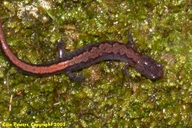|
Plethodon dorsalis Cope, 1889
Northern Zigzag Salamander, Zigzag Salamander Subgenus: Plethodon | family: Plethodontidae subfamily: Plethodontinae genus: Plethodon |
 © 2003 Lisa Powers (1 of 23) |
|
|
Country distribution from AmphibiaWeb's database: United States
U.S. state distribution from AmphibiaWeb's database: Alabama, Illinois, Indiana, Kentucky, Tennessee
Plethodon dorsalis Cope, 1889 Walter E. Meshaka Jr.1 1. Historical versus Current Distribution. Northern zigzag salamanders (Plethodon dorsalis) are distributed from southern Indiana southward through western and central Kentucky and central Tennessee (Thurow, 1966). The geographic range of northern zigzag salamanders was considered to include central Alabama and western Georgia until the discovery of Webster's salamanders (P. websteri), a sibling species (Highton, 1979) with a potentially narrow contact zone with southern zigzag salamanders (P. ventralis; Highton, 1985). Minton (2001) reports a reversal in relatively greater abundance from northern zigzag salamanders to eastern red-backed salamanders (P. cinereus) at an Indiana site. 2. Historical versus Current Abundance. Northern zigzag salamanders are seasonally abundant under moist leaf litter and flat rocks, often on wooded hillsides and ravines, along shale banks, and associated with sinkholes (Minton, 2001). They have also been found in caves (Miller et al., 1998). 3. Life History Features. A. Breeding. Reproduction is terrestrial. i. Breeding migrations. Do not occur. ii. Breeding habitat. Same as adult habitat. In Indiana, spermatozoa are present in vasa deferentia in October and April (Sever, 1978a), and sperm are present in females in November and March (Minton, 2001) and in April (Sever, 1978b). Egg laying in Indiana occurs in the spring, collections indicate from April–June (Sever, 1978b). B. Eggs. i. Egg deposition sites. Clutches are deposited within rock crevices, subterranean cavities, and in caves (Mohr, 1952; Smith, 1961; Mount, 1975; Miller et al., 1998). Logs appear to be avoided as nesting sites. Eggs rest on the substrate and are attended by the female (Mohr, 1952; Miller et al., 1998). ii. Clutch size. Clutches of closely related Ozark salamanders in Arkansas average 5.3 eggs (range = 3–9) and are produced annually (Meshaka and Trauth, 1995). C. Direct Development. i. Brood sites. Within rock crevices and underground. ii. Parental care. Females attend the nest during the summer, at which time they are absent from foraging sites (Wilkinson et al., 1993; Meshaka and Trauth, 1995). Hatchlings appear in the fall (Wilkinson et al., 1993; Meshaka and Trauth, 1995). D. Juvenile Habitat. Same as adults. E. Adult Habitat. Moist leaf litter, talus areas, and caves (Thurow, 1955; Minton, 2001). Northern zigzag salamanders prefer rocky habitat (Smith, 1961; Reinbold, 1979). Minton (2001) notes a preference for moist rocky slopes. This habitat serves to buffer salamanders from weather extremes, and the restricted availability of this habitat may limit the distribution and abundance of this species (Petranka, 1979). F. Home Range Size. Unknown. G. Territories. Unknown. H. Aestivation/Avoiding Dessication. Aestivation is unknown, however under dessicating conditions animals likely move under cover objects or into burrows. I. Seasonal Migrations. Unknown. However, in Arkansas, closely related Ozark zigzag salamander adults migrate to sandstone cedar glades from the forest during the courting season. Immature individuals are not found on the glade (Meshaka and Trauth, 1995). J. Torpor (Hibernation). Unknown. K. Interspecific Associations/Exclusions. In areas of syntopy, there is habitat separation between northern zigzag salamanders and eastern red-backed salamanders (Reinbold, 1979). Minton (2001) notes segregation between these species in Indiana, with northern zigzag salamanders exhibiting a preference for moist rocky habitats. Bausmann and Whitaker (1987) note more earthworms (Annelida) and fewer beetles (Insecta: Coleoptera) in the stomachs of northern zigzag salamanders when compared to eastern red-backed salamanders. L. Age/Size at Reproductive Maturity. Mature female northern zigzag salamanders in Indiana measure at least 35.6 mm SVL (Sever, 1978b; Minton, 2001). Both sexes of closely related Ozark zigzag salamanders are mature at 35 mm SVL and reproduce for the first time in the winter of their third year of life (Meshaka and Trauth, 1995). M. Longevity. Unknown. N. Feeding Behavior. Spiders and beetles comprised most of the diet of a fall and winter sample of northern zigzag salamander adults (Holman, 1955). O. Predators. Centipedes in the genus Scolopendra sp. are likely predators of the closely related Ozark salamanders (personal observations). P. Anti-Predator Mechanisms. Unknown. Q. Diseases. Unknown. R. Parasites. Unknown. 4. Conservation. Northern zigzag salamanders are listed as a Species of Special Concern in North Carolina, at the eastern edge of their distribution (Levell, 1997). As with other members of the Plethodon dorsalis complex, comprehensive life history and natural history studies of northern zigzag salamanders are necessary to obtain the knowledge required to make informed and effective management decisions. Acknowledgments. Richard Highton reviewed this account and provided valuable feedback. 1Walter E. Meshaka Jr. Current address: Literature references for Amphibian Declines: The Conservation Status of United States Species, edited by Michael Lannoo, are here. Feedback or comments about this page.
Citation: AmphibiaWeb. 2024. <https://amphibiaweb.org> University of California, Berkeley, CA, USA. Accessed 17 Apr 2024. AmphibiaWeb's policy on data use. |




 Raffaëlli Account
Raffaëlli Account Map of Life
Map of Life